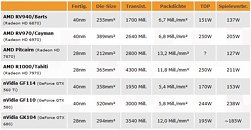- Joined
- Oct 9, 2007
- Messages
- 47,485 (7.49/day)
- Location
- Hyderabad, India
| System Name | RBMK-1000 |
|---|---|
| Processor | AMD Ryzen 7 5700G |
| Motherboard | ASUS ROG Strix B450-E Gaming |
| Cooling | DeepCool Gammax L240 V2 |
| Memory | 2x 8GB G.Skill Sniper X |
| Video Card(s) | Palit GeForce RTX 2080 SUPER GameRock |
| Storage | Western Digital Black NVMe 512GB |
| Display(s) | BenQ 1440p 60 Hz 27-inch |
| Case | Corsair Carbide 100R |
| Audio Device(s) | ASUS SupremeFX S1220A |
| Power Supply | Cooler Master MWE Gold 650W |
| Mouse | ASUS ROG Strix Impact |
| Keyboard | Gamdias Hermes E2 |
| Software | Windows 11 Pro |
A part of the reason why NVIDIA's performance-segment GK104 is gunning for the performance crown from AMD's Tahiti GPU could be hidden behind two of its key specifications: transistor count, and die-size. 3DCenter.org compiled these two specifications for the GK104 from reliable sources, which pin the transistor count at 3.54 billion, and die-area at 294 mm². This yields a transistor density of 12 million per mm², which is slightly higher than that of AMD Tahiti, slightly lower than that of AMD Pitcairn, and certainly higher than previous-generation chips from both AMD and NVIDIA. If GeForce GTX 680 does in fact end up competitive with AMD's Radeon HD 7900 series, it could serve as a tell-tale sign of NVIDIA's Kepler architecture being a more efficient one.

View at TechPowerUp Main Site

View at TechPowerUp Main Site









